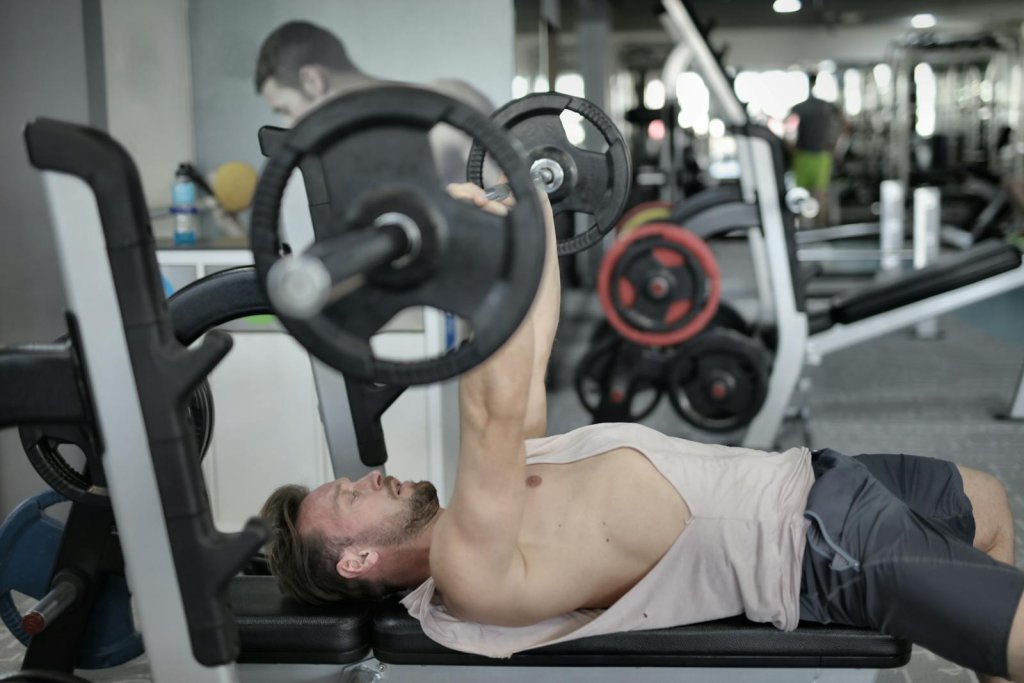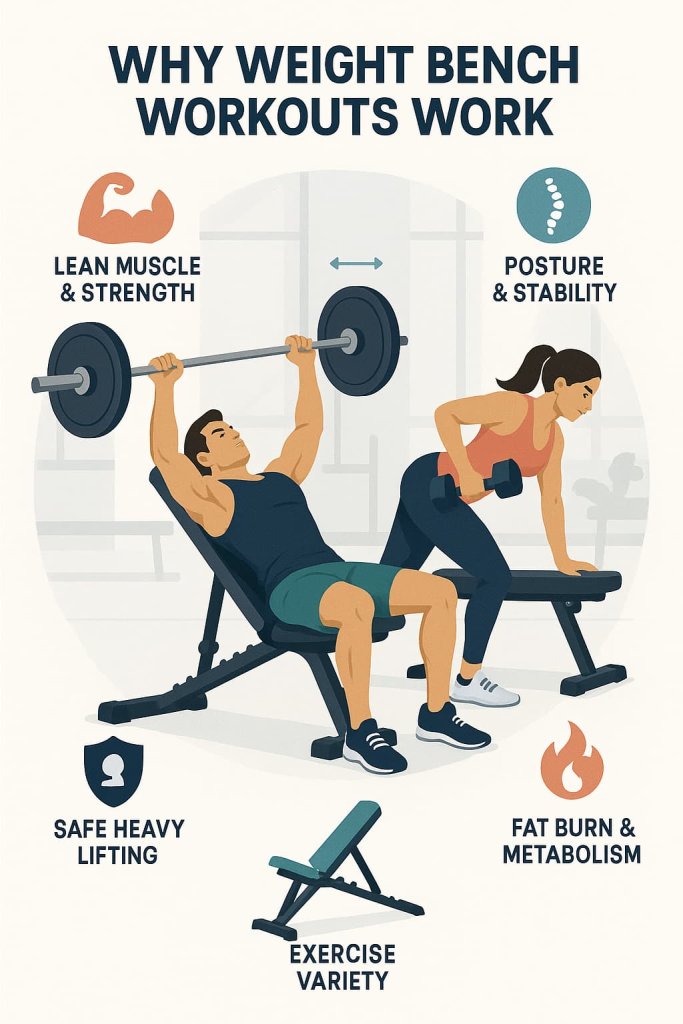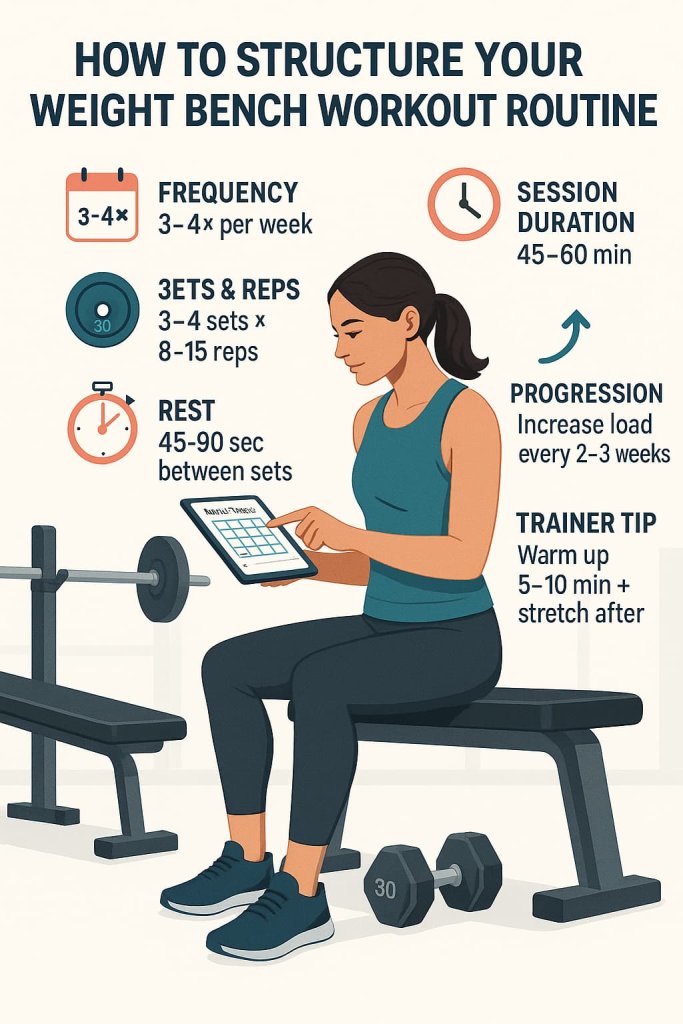The best weight bench workouts build muscle, boost strength, and sculpt definition — all from one versatile piece of equipment. A workout bench isn’t just for bench presses; it’s your all-in-one tool for a full-body transformation. Whether your goal is to grow muscle mass, increase strength, or improve tone, the bench offers stability, range, and progression for every fitness level.

This guide breaks down the 20 best weight bench exercises to target your chest, arms, back, legs, and core — complete with structure, safety tips, and expert advice.
Why Weight Bench Workouts Work
A weight bench provides support, stability, and versatility — letting you safely perform compound lifts and isolation exercises through a full range of motion.

According to Healthline (2024), bench-based movements like the chest press and dumbbell row activate multiple muscle groups, building strength and endurance while minimizing injury risk. Adjustable benches also help you hit muscles from different angles for better symmetry and definition.
Benefits include:
- Builds lean muscle and total-body strength
- Improves posture and joint stability
- Allows heavier, safer lifting
- Boosts metabolism and fat burn
- Increases exercise variety and progression options
How to Structure Your Weight Bench Workout Routine

Frequency: 3–4 times per week
Session Duration: 45–60 minutes
Sets & Reps: 3–4 sets of 8–15 reps per exercise
Rest Between Sets: 45–90 seconds
Progression: Gradually increase load or reps every 2–3 weeks
Trainer Tip: Always warm up (5–10 minutes of cardio + mobility drills) and cool down with stretching.
20 Best Weight Bench Workouts
These 20 weight bench workouts target every major muscle group — from chest and shoulders to legs and core.
Incorporate them into your weekly routine to build strength, definition, and total-body balance efficiently.
Upper Body Weight Bench Workouts
1. Flat Barbell Bench Press
Why it works:
This classic compound movement builds the foundation of upper-body strength. It activates your chest, shoulders, and triceps simultaneously, improving pushing power and muscle mass. Research from Healthline (2024) shows the flat bench press recruits more muscle fibers in the pectorals than most other chest exercises, making it the go-to for total upper-body development.
Muscles worked:
Pectoralis major, anterior deltoids, triceps brachii.
How to do it:
- Lie flat on the bench with eyes aligned under the bar.
- Grip slightly wider than shoulder width.
- Lower the bar slowly to mid-chest, keeping elbows at about 45°.
- Push explosively back up to full extension.
- Repeat for 8–12 reps.
Trainer Tip:
Retract your shoulder blades and keep your feet firmly on the ground to create stability and protect your shoulders.
2. Incline Dumbbell Press
Why it works:
This move shifts the focus to the upper chest and front shoulders, helping create a fuller, more defined chest. The dumbbell version allows greater range of motion and muscle activation on each side for symmetry and control.
Muscles worked:
Upper pectorals, anterior deltoids, triceps.
How to do it:
- Set the bench to a 30–45° incline.
- Hold dumbbells at shoulder level with palms facing forward.
- Press them upward until arms are extended without locking elbows.
- Lower slowly to the starting point.
Trainer Tip:
Avoid using momentum — a controlled tempo increases muscle tension and growth.
3. Decline Bench Press
Why it works:
Targets the lower chest fibers, providing complete pectoral development. The decline angle also reduces shoulder strain and emphasizes triceps more than the flat press.
Muscles worked:
Lower chest, triceps, shoulders.
How to do it:
- Adjust bench to a 15–30° decline.
- Grip barbell shoulder-width apart.
- Lower bar to the lower chest.
- Press back up until elbows are straight but not locked.
Trainer Tip:
Keep your wrists straight and control the bar path — don’t let gravity take over.
4. Dumbbell Fly
Why it works:
Isolates the chest muscles to enhance width, flexibility, and definition. Great as a finisher after pressing movements.
Muscles worked:
Pectoralis major, anterior deltoids.
How to do it:
- Lie flat on a bench holding dumbbells over chest, palms facing each other.
- Slowly open arms in a wide arc until you feel a stretch.
- Bring weights back together in a hugging motion.
Trainer Tip:
Maintain a slight elbow bend throughout to prevent joint strain.
5. Dumbbell Pullover
Why it works:
An underrated exercise that strengthens both the chest and back while expanding the rib cage and improving shoulder mobility.
Muscles worked:
Chest, lats, triceps, serratus anterior.
How to do it:
- Lie perpendicular to the bench with only shoulders supported.
- Hold a dumbbell above chest with arms extended.
- Lower weight behind head in a slow arc.
- Pull back up using chest and lats.
Trainer Tip:
Keep hips low and engage your core to prevent overextension of the spine.
6. Seated Shoulder Press
Why it works:
Builds powerful shoulders and triceps, improving posture and upper-body strength. The seated position minimizes leg assistance, forcing your shoulders to do all the work.
Muscles worked:
Deltoids (especially anterior), triceps, upper chest.
How to do it:
- Sit upright with back against the bench.
- Hold dumbbells at ear level, palms forward.
- Press overhead until arms are fully extended.
- Lower slowly to starting position.
Trainer Tip:
Do not arch your lower back — brace your core and keep ribs down.
7. One-Arm Dumbbell Row
Why it works:
A staple for back thickness and posture correction. It targets your lats while engaging stabilizers in your core and shoulders.
Muscles worked:
Lats, traps, rear delts, rhomboids, biceps.
How to do it:
- Place left knee and hand on bench, right foot flat on floor.
- Hold dumbbell in right hand.
- Pull weight toward hip, squeezing shoulder blade.
- Lower under control.
Trainer Tip:
Avoid twisting your torso — let your back do the work, not momentum.
8. Incline Dumbbell Curl
Why it works:
Maximizes biceps stretch and contraction for size and symmetry. The incline angle prevents cheating by reducing shoulder involvement.
Muscles worked:
Biceps brachii, brachialis.
How to do it:
- Sit on a 45° incline bench, arms hanging down.
- Curl dumbbells upward, keeping elbows stationary.
- Squeeze at top, lower slowly.
Trainer Tip:
Perform slowly to maintain full tension — it’s not about speed.
9. Lying Triceps Extension (Skull Crusher)
Why it works:
An isolation movement for building the triceps — essential for stronger pressing power and arm definition.
Muscles worked:
Triceps brachii.
How to do it:
- Lie flat, holding a barbell or dumbbells above chest.
- Lower weight toward forehead, keeping elbows still.
- Extend arms back to start.
Trainer Tip:
Keep upper arms locked in place — only your forearms should move.
Lower Body & Core Weight Bench Workouts
10. Bulgarian Split Squat
Why it works:
Builds powerful, athletic legs while improving balance and unilateral strength. It’s one of the most effective exercises for glute and quad development.
Muscles worked:
Glutes, quadriceps, hamstrings, calves.
How to do it:
- Stand 2–3 feet in front of bench.
- Place one foot behind on the bench.
- Lower into a lunge until front thigh is parallel.
- Push through front heel to rise.
Trainer Tip:
Keep front knee in line with toes — not forward beyond them.
11. Step-Up
Why it works:
A functional move that mimics everyday actions like climbing stairs. It boosts balance, coordination, and leg symmetry.
Muscles worked:
Quads, glutes, hamstrings.
How to do it:
- Stand facing bench holding dumbbells.
- Step onto bench with one foot, drive through heel.
- Step down under control.
- Alternate sides.
Trainer Tip:
Use a height that keeps your knee around 90° — too high strains joints.
12. Bench Hip Thrust
Why it works:
Top-tier move for glute activation, improving strength, shape, and posture.
Muscles worked:
Glutes, hamstrings, core.
How to do it:
- Sit with upper back on bench, knees bent, feet flat.
- Place weight on hips.
- Lift hips until body forms a straight line.
- Lower slowly and repeat.
Trainer Tip:
Keep chin tucked and ribs down to fully engage the glutes.
13. Seated Leg Raise
Why it works:
Strengthens lower abs and hip flexors, improving core stability and pelvic control.
Muscles worked:
Lower abs, hip flexors.
How to do it:
- Sit on the bench, lean back slightly.
- Lift legs together until parallel.
- Lower without touching the ground.
Trainer Tip:
Keep core braced and avoid swinging legs.
14. Reverse Hyperextension
Why it works:
Safely strengthens the lower back and glutes while improving spinal health and posture.
Muscles worked:
Glutes, hamstrings, erector spinae.
How to do it:
- Lie face down on bench, hips at edge.
- Hold onto sides for support.
- Lift legs behind until aligned with torso.
- Lower slowly.
Trainer Tip:
Avoid jerking motions — slow, controlled lifts are safest.
15. Bench Plank Row (Renegade Row)
Why it works:
A hybrid strength-and-stability move that builds the core and upper back simultaneously.
Muscles worked:
Core, lats, shoulders, triceps.
How to do it:
- Place hands on bench in plank position.
- Row one dumbbell toward your hip, alternating sides.
- Keep body stable throughout.
Trainer Tip:
Tighten your glutes and abs — no hip rotation.
16. Bench Jump
Why it works:
Builds explosive lower-body power and agility while burning calories fast.
Muscles worked:
Quads, glutes, calves.
How to do it:
- Stand facing bench.
- Swing arms and jump onto bench with both feet.
- Land softly, then step down.
Trainer Tip:
Use a safe, moderate height to prevent knee stress.
17. Lying Leg Curl (with Dumbbell)
Why it works:
Strengthens hamstrings and improves balance between front and back leg muscles.
Muscles worked:
Hamstrings, glutes.
How to do it:
- Lie face down on bench, dumbbell between feet.
- Curl legs upward, squeezing hamstrings.
- Lower slowly.
Trainer Tip:
Engage core and keep hips down to avoid arching your back.
18. Bench Pike Push-Up
Why it works:
A challenging bodyweight move that targets shoulders, triceps, and upper chest — mimicking an overhead press.
Muscles worked:
Shoulders, triceps, core.
How to do it:
- Place feet on bench, hands on floor forming a pike.
- Lower head toward floor.
- Push back up to start.
Trainer Tip:
Keep neck neutral and elbows tracking inward.
19. Decline Sit-Up
Why it works:
Strengthens upper and lower abs for a more defined midsection. The decline angle increases resistance.
Muscles worked:
Rectus abdominis, obliques.
How to do it:
- Secure feet under bench pads.
- Lean back until just above parallel.
- Crunch up, exhaling at the top.
Trainer Tip:
Avoid pulling on your neck — focus on using your abs to lift.
20. Bench Mountain Climber
Why it works:
Combines cardio and core work for total conditioning. It improves endurance and fat burn while toning abs.
Muscles worked:
Core, shoulders, hip flexors, legs.
How to do it:
- Place hands on bench, feet extended behind.
- Drive knees toward chest alternately at steady pace.
Trainer Tip:
Keep back flat and tempo controlled for proper engagement.
Safety Tips Before You Start
Before beginning any weight bench workout, follow these key safety steps to protect your joints and maximize results:
- Warm Up: 5–10 minutes of light cardio and dynamic stretches.
- Check Equipment: Ensure the bench is stable and secure.
- Start Light: Focus on form before increasing weight.
- Use a Spotter: Especially for heavy lifts or barbell presses.
- Avoid Pain: Stop immediately if you feel sharp discomfort.
- Stay Hydrated: Drink water and rest between sessions.
- Seek Guidance: Consult a trainer or doctor if you’re new or have injuries.
Trainer Tip: A proper warm-up and good form are your best injury prevention tools.
FAQs
1. Can I get a full-body workout using just a weight bench?
Yes — a bench allows upper, lower, and core exercises, making it ideal for complete home workouts.
2. How many times per week should I use a weight bench?
Three to four sessions weekly with rest between muscle groups is optimal for muscle growth and recovery.
3. What’s better: flat or adjustable bench?
An adjustable bench offers more versatility — you can train chest, shoulders, and even legs more effectively.
4. Should beginners use a weight bench?
Absolutely. Start with bodyweight or light dumbbells to learn proper form before progressing.
5. How long until I see results?
With consistent training and nutrition, most people notice visible strength and muscle gains in 6–8 weeks.
6. Can I lose fat using a weight bench?
Yes — strength training boosts metabolism and calorie burn, especially when paired with a balanced diet.
7. What equipment do I need besides the bench?
A set of dumbbells, resistance bands, and a barbell (optional) can expand your exercise variety.
Conclusion
A weight bench is more than gym furniture — it’s a total-body training platform. From pressing power to glute strength, these 20 exercises cover every major muscle group for visible, lasting results.
Start today: Pick 6–8 moves, train 3–4 times weekly, and progress gradually. Within weeks, you’ll feel stronger, leaner, and more confident than ever.
References
- American College of Sports Medicine — Physical Activity Guidelines (2024 update)
https://acsm.org/education-resources/trending-topics-resources/physical-activity-guidelines/ - U.S. Dept. of Health & Human Services — Physical Activity Guidelines for Americans, 2nd ed.
https://health.gov/sites/default/files/2019-09/Physical_Activity_Guidelines_2nd_edition.pdf - Mayo Clinic — Weight training: Do’s and don’ts
https://www.mayoclinic.org/healthy-lifestyle/fitness/in-depth/weight-training/art-20045842 - British Journal of Sports Medicine (2024) — Systematic review: warm-up injury-prevention programs
https://bjsm.bmj.com/content/58/11/615 - Journal of Strength & Conditioning Research — Presence of Spotters Improves Bench Press Performance
https://journals.lww.com/nsca-jscr/fulltext/2019/07000/presence_of_spotters_improves_bench_press.3.aspx
